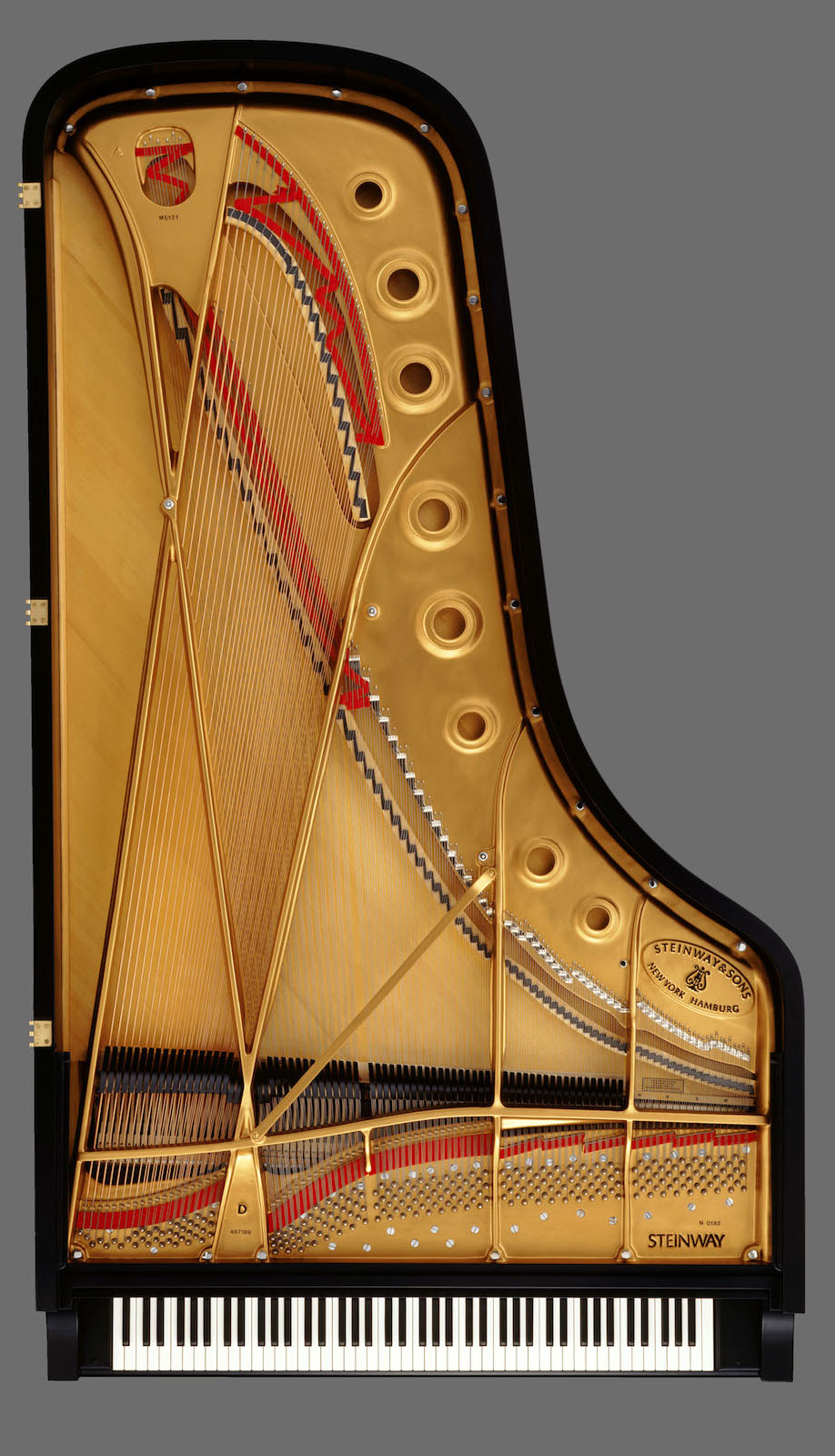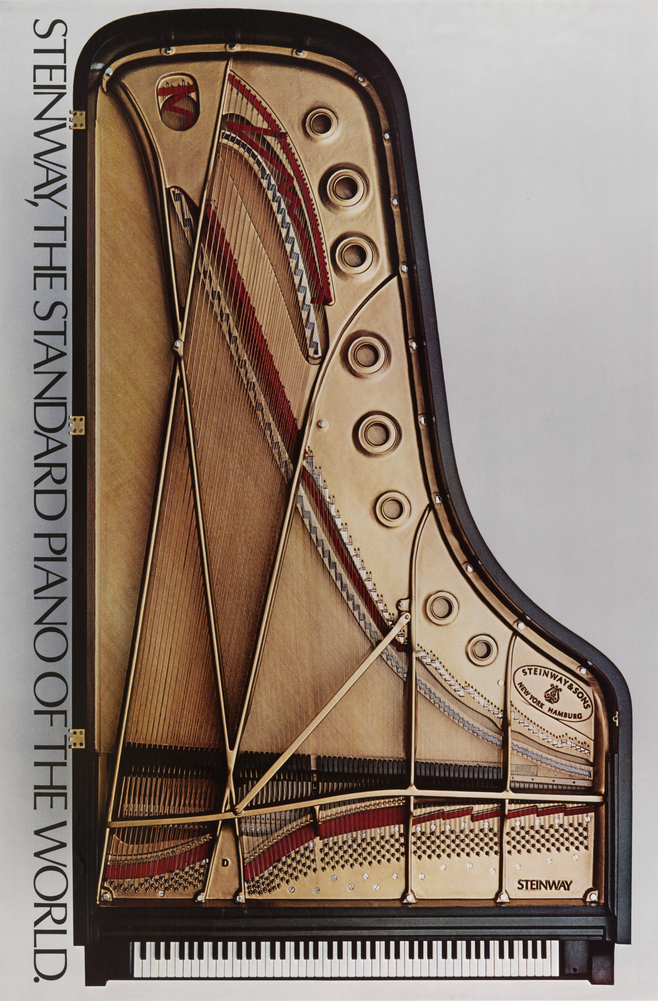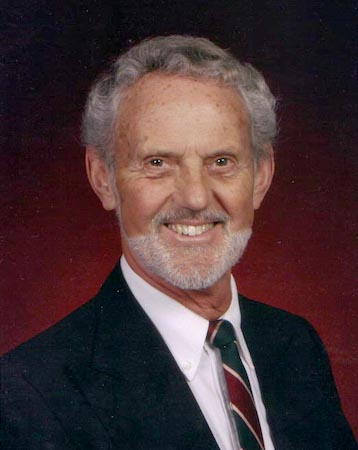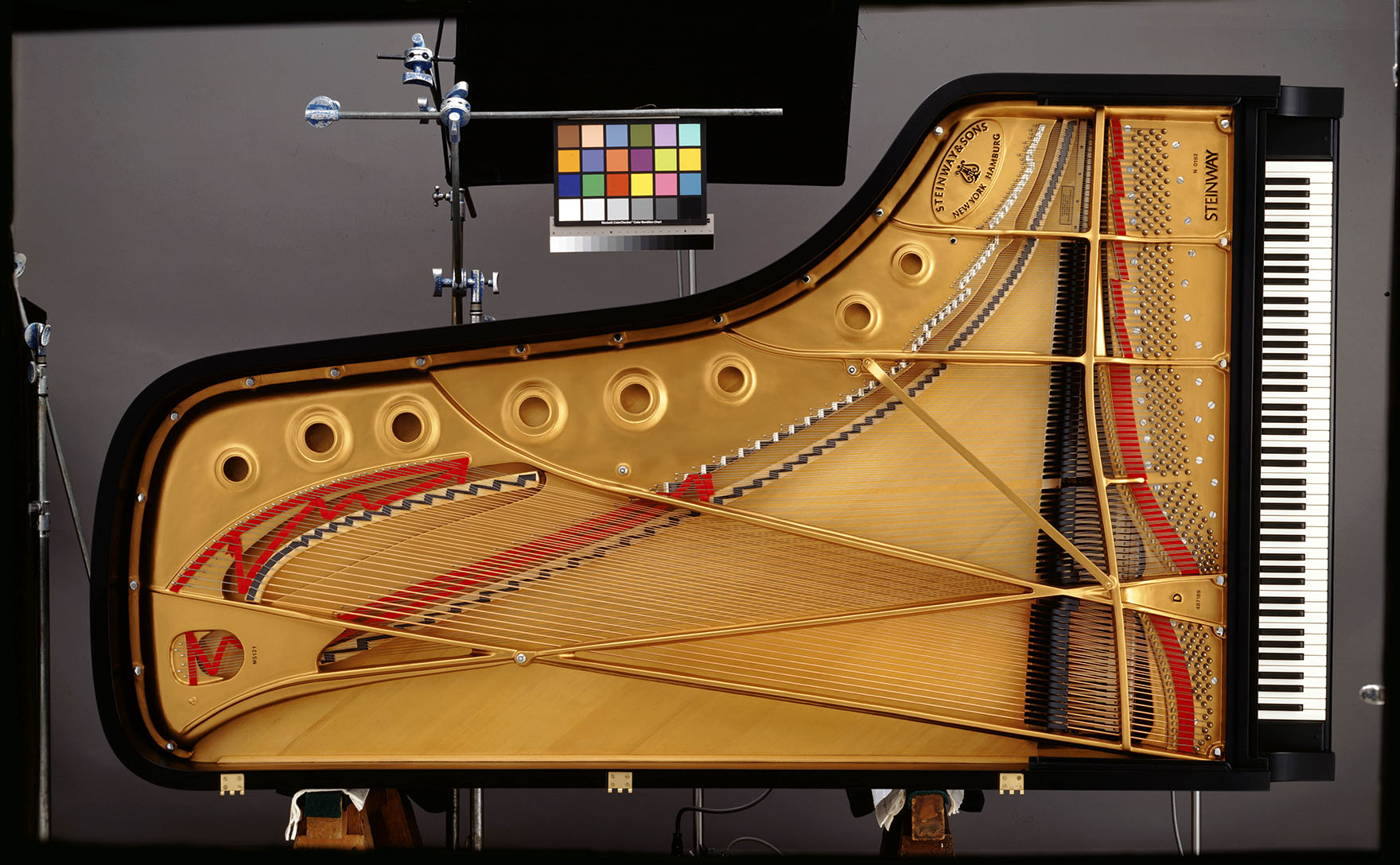Concert Grand
an art poster
published in 1984
22"x28"
“The best photo of a piano ever made.”
-- Henry Z. Steinway
(see below)
Produced by David Yost
Art Direction: Lynn Yost
Lighting Design: David Yost
Photography: Douglas Hopkins
Stylist: Bill Garlick
Steinway Model D Concert Grand Courtesy of Steinway & Sons at the factory
You can purchase a copy of this poster from Steinway & Sons 718 721 2600
This image also appeared on the cover of the opulent book Steinway
and has had many other uses.
For example, a cutout of the poster was used as the interior of
a 1/3-scale model of the commemorative 500,000th Steinway (see below).
For permission to use the image, please contact
Steinway & Sons, 800 366 1853 or 718 721 2600
It is available as a 62MB masked Photoshop file.
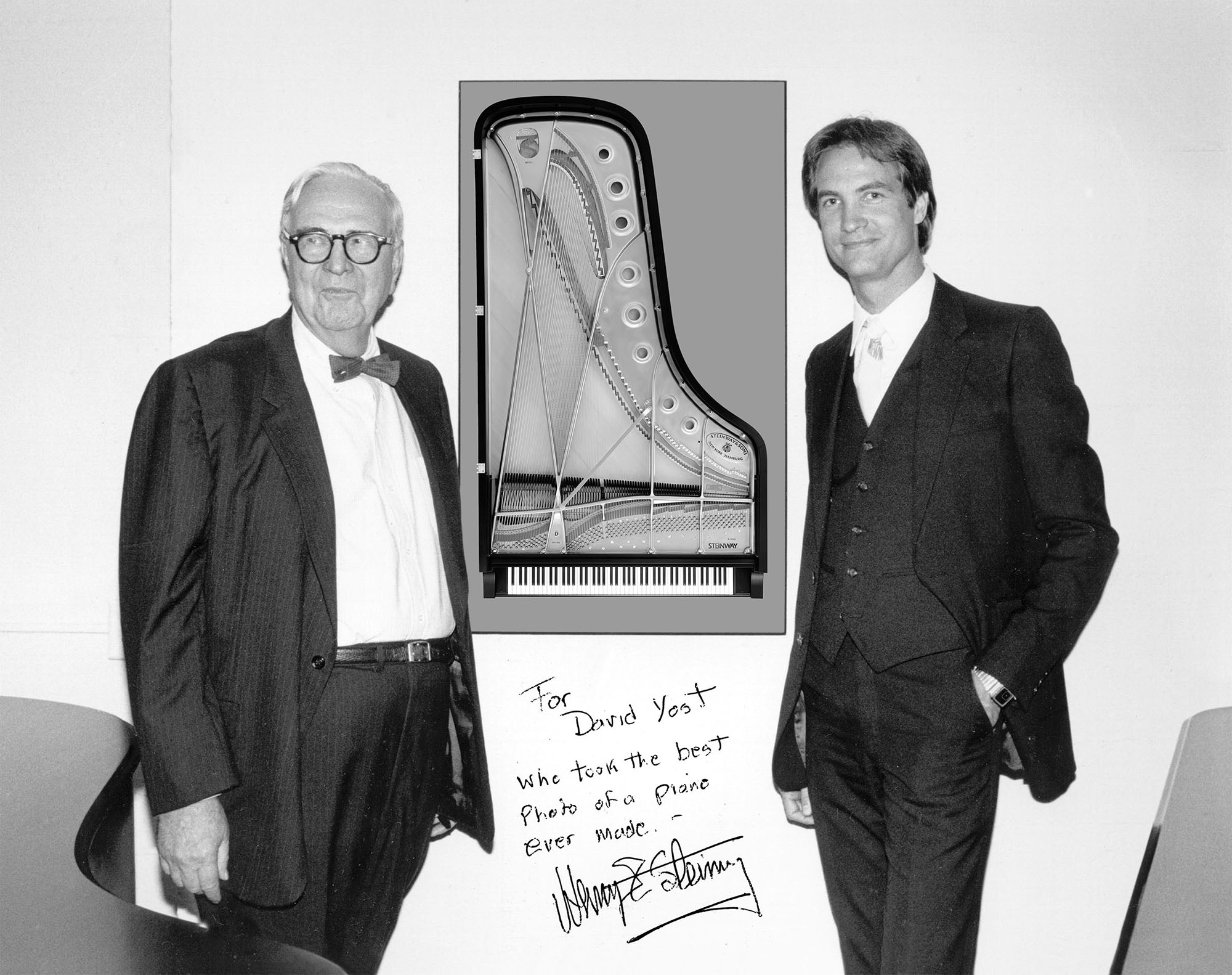 |
| © Silvia Mautner 1986 - Thanks to Doug Lee, then of Sherman Clay, Los Angeles, for getting us both in front of this photographer. |
I have to say a little about Henry Z. and the experience of making this poster.
Steinway Hall
From the time I was a teenager and visited New York on trips with my parents, I have periodically made pilgrimages to Steinway Hall on 57th Street. There I would wander down the hallway, looking at the paintings of lionized pianists on the walls and at the display cases along the left wall, containing letters to and from greats such as Rachmaninoff, Horowitz, and Hoffman. All well and good, but I was headed for the curtained, double French doors to the grand salon all the way at the back, facing 58th Street. I would quietly close these doors and then settle in at the Model D against the wall on the right. Here I would play my heart out, free from the mundane struggles with technique and memory that dogged everyday playing at home on a far-inferior piano. The music would pour out, coaxed to greater and greater heights by this adoring partner. Many of those Ds over the years were to die for. It has been a lifelong goal of mine to own two of them, side by side in a nice big room.
Over the years I did this many times, always on alert for someone to come in and cut it short with a “May I help you?”. No one ever did.
Sadly, Steinway’s 57th Street site was closed at the end of 2014.
The old poster
Then one day, as I was perusing the display cases along the hallway to the back room, I was stunned to see on the opposite wall a poster of a D in the same pose as you see above. Wow! Great idea! —
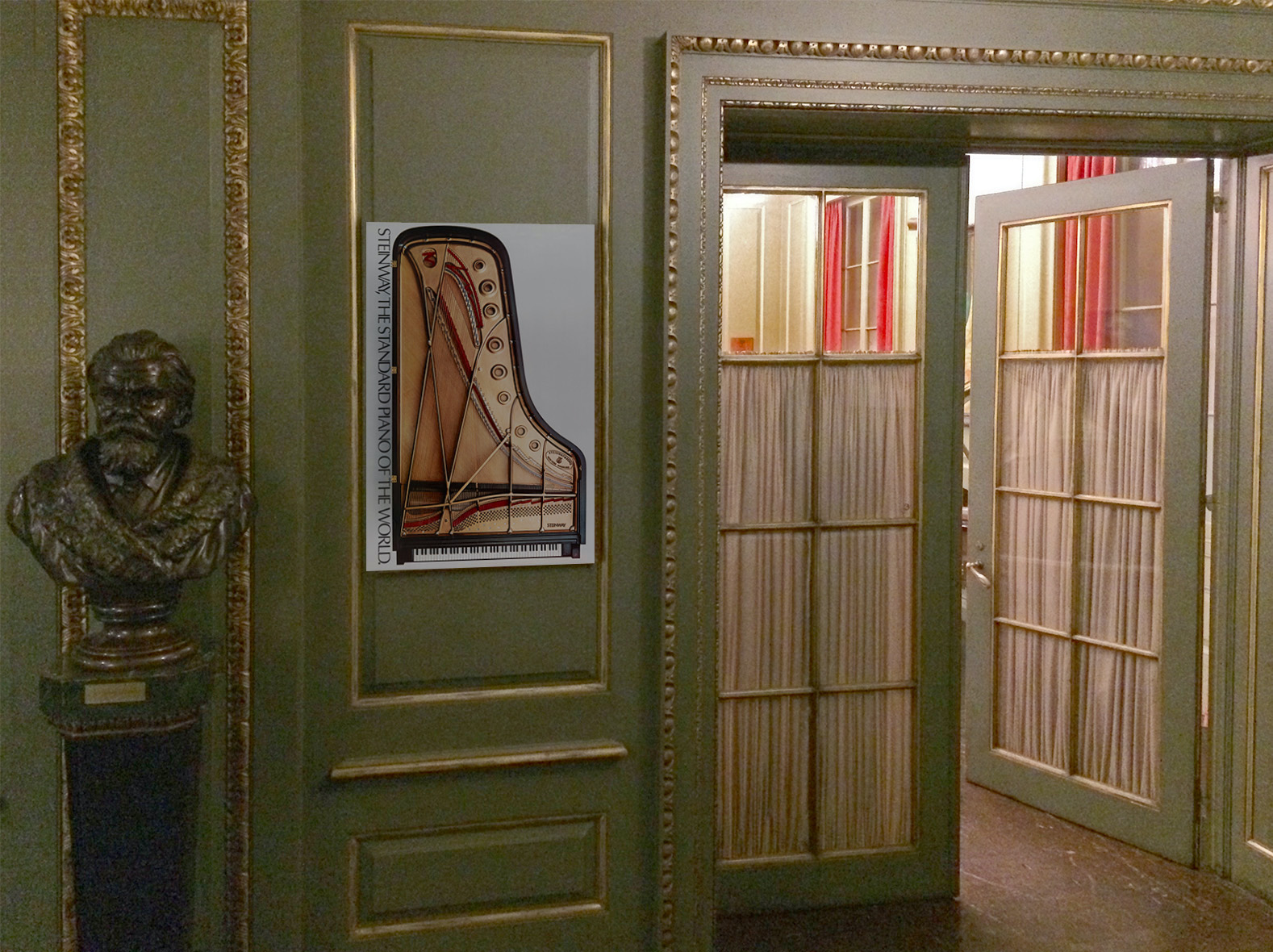
The old poster hanging in Steinway Hall (simulated, using the image from the Cooper-Hewitt collection)
Yuck! — Everything about the execution of that poster was wanting. I decided on the spot that I wanted to do a worthy remake.
Some days later I called Steinway to ask if it would be OK. I was put through to David Rubin, then VP of Marketing, at the factory in Astoria (Queens) a few miles to the east. “I would like permission to do an opulent remake of the poster of the Model D. Would you...” He had heard enough. He interrupted, “Just call [our PR agency] and tell them when and where you want a piano,” Turns out that he hated that other poster and loved the idea of a remake so much that he didn’t care who I was; I must know what I was doing, and he was for it.
At the factory
Soon thereafter, a new Steinway Concert Grand Model D was waiting for me on the second floor of the factory, up on its side on velvet-padded sawhorses, near the Selection Room. It was so new, the plate still had its temporary serial number N 0182 above the name STEINWAY, in addition to its final serial number, 487189, under the D.
Legendary technician and teacher Bill Garlick, then chief technician at Steinway in New York, came out from his office right next to where we were shooting and pitched in as make-up artist, going over every inch of the instrument, cleaning smudges off the strings and straightening little things up here and there. (Bill later took me on a fascinating tour of the factory. A must for piano fans.)
Photographing a 9-foot jewel
When you photograph jewelry, you place large, white, soft light around the subject, like this. The idea is that if you were the piece of jewelry looking out into the world, just about everything you see should be white. I wanted to achieve a similar effect for this nine-foot-long piece of jewelry.
Early on the morning of Monday, March 26, 1984, I rented a truck and a bunch of equipment then spent hours at the factory setting up while Byron Janis with his wife Maria Cooper Janis at his side tried out pianos through the double doors in the Selection Room. After a full day building a large temporary “tent” made of floor-to-ceiling white paper, hooking up seven flash units to reflect off the white paper, and placing the 8x10 camera with 36 inch lens 28 feet away from the piano at the other end of the tent, and after an all-night session of test Polaroids and lighting adjustments critiqued by my art director sister Lynn Yost Kent, the exposed Ektachrome film was in the lightproof box. Eight months later, in Lucerne, Switzerland, the poster was born.
Henry Z.
On subsequent visits to New York, I had one fascinating chat with Henry Z’s late brother John just before John passed away and then several also fascinating and delightful encounters with Henry Z. Both Steinways were very kind, engaging, and interesting. One time, Henry Z showed me a closet in the basement that had a trove of original large-format, glass negatives and some remaining copies of nineteenth-century marketing brochures—and he gave me some of the brochures!
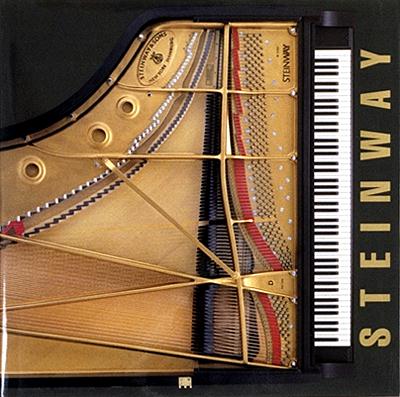
Then five years later, the Steinway book came out, with the photo on the cover. Living in New York at the time, I was invited to the book party at Steinway Hall. And so it was that finally, on the evening of this party, after years of sneaking into Steinway Hall to play Ds, I walked into the rotunda one more time. This time Henry Z. himself was standing there. He lit up when I came in and said, “Oh, David, so glad you could come.”
I’ve encountered Henry Z. only once or twice since. In early 2005 on a visit to Steinway Hall, I was there on the wrong day of the week to catch him in, but I did see a lovely, wide poster of a Steinway keyboard, with the title, “Happy 88th, Henry Z.”
In the Fall of 2005 I expanded this web page. Soon thereafter I called Henry Z and invited him to have a look, which he did (via printout). The result is this voicemail message, which captures this lovely man better than any written words can.voicemail from Henry Z
I saw Henry Z again in the fall of 2006. He graciously took me and a friend on a tour of Steinway Hall and shared its wonders as if for the first time rather than the millionth time. On the wall there is a Steinway family tree. It starts at left in the mid 1800s with one family, and as time marches on into the 1970s, you can see that there are many descendents. I ran my finger down the long list of descendants at the peak, around 1972 when he sold Steinway to CBS and said, “My. This must be why you had to sell to CBS.” Henry Z chuckled. “In a nutshell.”
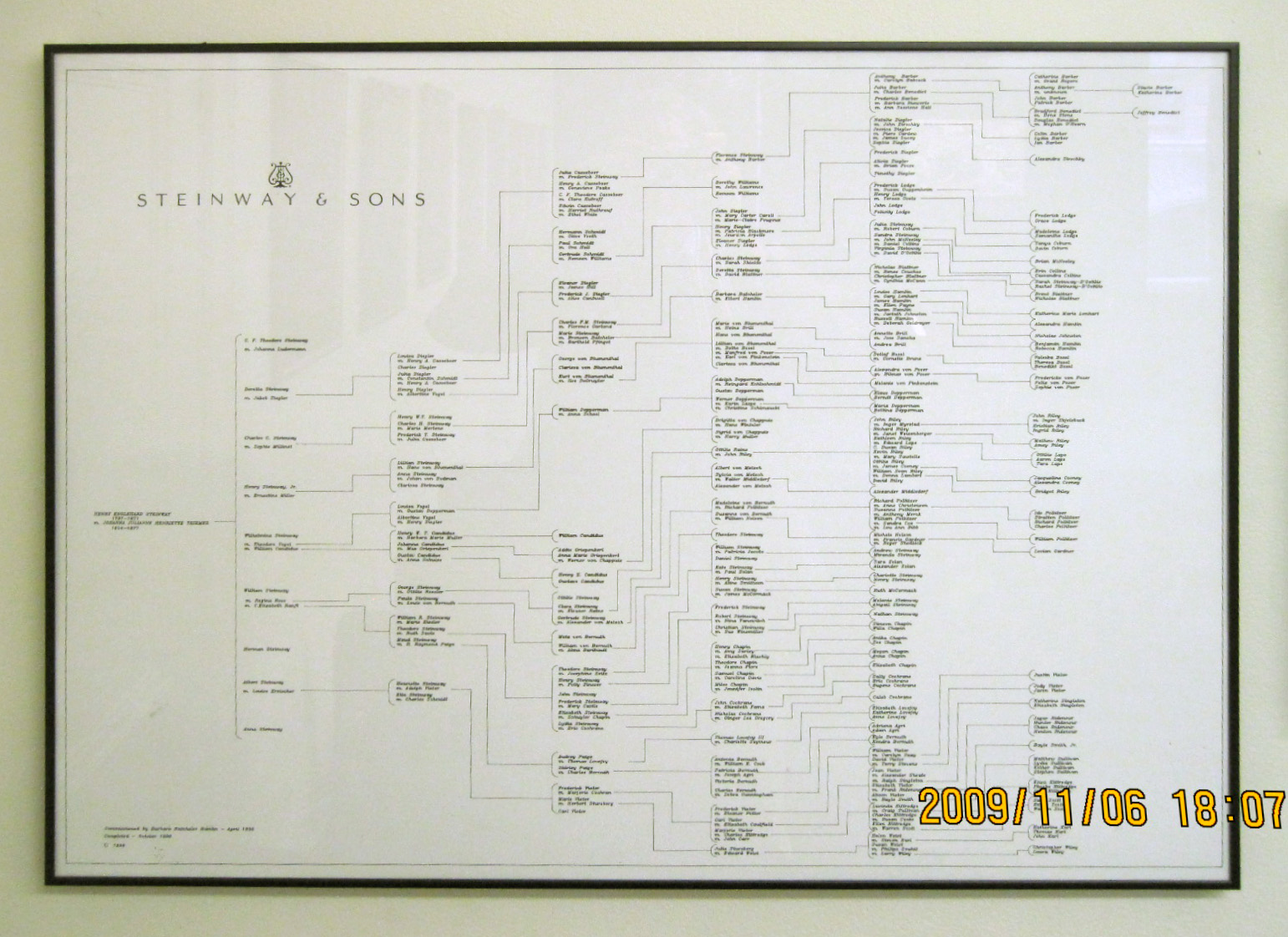
NAMM show
A few months after the poster came out, Steinway invited me to their suite at the NAMM show in Anaheim, not far from my home at the time in the Hollywood hills. The annual National Association of Music Merchants convention is a huge, cacophonous affair; it was a good thing that Steinway had a suite away from it all. There, semi-reclining on the couch, was David Rubin, holding court. I had not thought of him as a generous or terribly friendly man, judging from previous encounters. In 1973 I had rented a D from him for friend Roman Markowicz’s senior recital at Manhattan School of Music; on that occasion he came off as rather condescending. Then a couple of years later I snuck into the Dress Circle at Carnegie Hall to hear Horowitz rehearse (I know three others who did the same thing!). From under the Dress Circle overhang, I heard a familiar booming voice. David Rubin! Volodya had complained about the sound, and David Rubin intoned, “Have them move the curtains in one foot.” Oh God, Volodya, I thought, please don’t fall for this; you’re all recovered, right? The curtains budged. Volodya played a little, then stopped. “I can’t hear any difference,” he said. Thank you, Volodya.
At Steinway’s suite at the NAMM show, David Rubin gave me a pleasant surprise. He simply gushed over the poster, listing everything about it that was improved over the old one, which he had hated. (He particularly appreciated that I made sure you could see the entire length of the keys and that there was ample space below the keyboard.) Clearly he was a man of taste!
It was also on this occasion—I can’t leave this out—that software guru / polymath Michael Hawley and I arranged to meet at Steinway’s hotel suite. There in this large room with balcony were all the Steinway executives and regional sales managers in their dark suits. In walks this kid with scruffy red hair and beard, sneakers, and jeans, looking every bit the rocker. One and all stiffened as he walked in. I greeted him, which probably only served to make me suspect, too. Concert Rentals manager Richard Probst was playing some Bach on the 7' grand. When he finished, Mike sat down. The only thing that would have made the moment more perfect would have been if just then someone had dropped a tray full of champagne glasses with a crash. The dread in the room was palpable. David Rubin was just about to call from his throne for the Centurians. Then Mike began to play the Kreisler-Rachmanninoff LiebesLeid, like this (see Mike's page).
The tense mood melted away. When Mike finished, David Rubin, God bless him, erased any vestige of tense feelings by pleading, “Oh, you play that so beautifully. Please, play it again.” Mike smiled and complied. Years later, Mike went on to win the 2002 Van Cliburn Competition for Outstanding Amateurs.
Other uses
Steinway commisioned a 1/4 scale model of “Steinway No. 500000”, which was made using a copy of the poster for the interior:

And there is a 3D model of a Steinway D that uses the poster photo for the interior.
Article The Making of a Steinway Grand by Michael Lenehan
Coda, a 2019 film includes a scene filmed in the New York City showroom of Steinway.

Conclusion
Where did the piano in the photo end up? Someone told me they encountered it in the home of a physician in Washington, DC.
It has been a lovely experience to be a friend of Steinway the company and Henry Z. Steinway the man over the years and to get to meet and work with some stellar people, among them Leo Spellman, Peter Goodrich, Bill Garlick, Franz Mohr, Gene Inman, the late Richard Probst and many others.
Don't miss this lovely film, Note by Note: The Making of Steinway L1037, streaming on Vimeo.
Check out my other art poster, Fifth Avenue.
David Arthur Yost, Yost.com, All Rights Reserved.http://Yost.com/art/steinway/ - this page
1996-08-27 Created
2005-08-22 Added everything from B&W photo down
2006-03-15 Modified
2007-05-15 Corrected Mohr spelling
2007-06-08 Removed mention of note cards no longer sold by Steinway
2008-09-18 Added Henry Z voicemail
2009-12-06 render audio as ordinary links
2012-04-03 headings
2013-06-03 Replace Leo Spellman with Todd Sanders
2013-12-08 Retina resolution for some photos, added Steinway family tree
2014-09-02 added images of the old poster and 3D model
2014-10-31 added a description meta tag
2015-03-09 added photos of Steinway family tree and 500,000th Steinway
2017-10-16 link to Bill Garlick at the Piano Technicians Guild
2020-04-26 html5 audio for Henry Z voicemail, touch-ups
2020-06-08 link to article by Michael Lenehan
2021-04-03 Coda movie frame
2022-04-28 Photo credit added
2022-08-23 Typos
